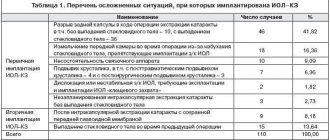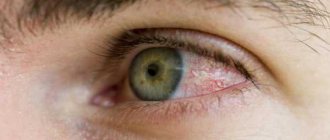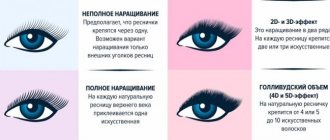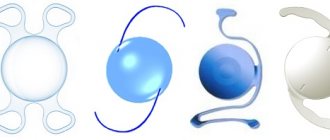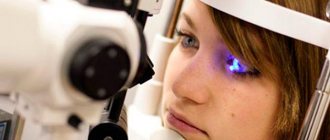About company
The American company Alcon is one of the world leaders in the production of intraocular lenses. Its doctors have developed a revolutionary material that meets the requirements of modern ophthalmology.
Alcon intraocular lenses appeared on the market in 1994. Since then, eye doctors around the world have been using the products to restore vision in patients with varying degrees of myopia, farsightedness, astigmatism or cataracts. Patients note improved vision, do not feel pain and burning and other side effects of operations.
Reviews from ophthalmologists
Olga, ophthalmologist: I have been working as a surgeon for more than 20 years. Relatively recently, lens diseases began to be treated correctly. If cataracts occur that cannot be cured with medication, I prescribe surgery. I remove the cataract and install an intraocular lens in its place. The company most often recommended is Rainer; in my practice there have been no complications when using it.
Vladimir, ophthalmologist: People with cataracts often come to me. If it has developed to a severe degree, I recommend surgery. If the cataract is replaced with an intraocular lens in time, the patient's vision can be completely improved. Quite often I install a model from Rainer; it has a hypoallergenic composition; to install it, you need to make a minimal incision.
Lens Features
AcrySof® intraocular lenses have the following characteristics:
- precise and smooth surface, which has a beneficial effect on the condition of eye tissues;
- the material from which the lens is made does not cause an allergic reaction;
- the lens is correctly positioned in the eye thanks to a specially designed design;
- microscopic lens thickness;
- Thanks to a wide range of models, lenses are used for all categories of patients with visual impairments;
- the lenses are equipped with a filter against ultraviolet radiation;
- their design is improved thanks to a yellow filter that blocks blue light;
- The lenses provide 100% vision at any distance.
AcrySof® IQ
This intraocular lens is called “intelligent” because it corrects optical aberrations well and provides good vision under any conditions. Used for implantation into the eye after cataract removal.
Typically, after such an operation, many patients regain good vision. However, at dusk or at night they are bothered by flashes of light, reflections and other effects that conventional spherical lenses exhibit. The AcrySof IQ lens provides normal vision due to its uneven thickness.
The lenses are made of biocompatible acrylic. They are distinguished by the presence of a biconvex fragment. The lens completely corrects astigmatism.
Lens models:
- SND1T2-T5;
- SN60WF AcrySof IQ;
- ACRYSOF IQ NATURAL.
Types of intraocular lenses (IOLs)
An artificial lens (intraocular lens) is implanted in place of the natural lens after cataract surgery or refractive lens replacement. Intraocular lenses are divided into “hard” and “soft”. “Rigid” intraocular lenses do not have a flexible, permanent shape, so their implantation requires a large surgical incision and subsequent suturing, which significantly increases the rehabilitation period. Most modern ophthalmological centers and clinics prefer “soft” intraocular lenses, which are made of elastic synthetic polymers. Such lenses are implanted through a self-sealing micro-incision of about 2.5 mm. and do not require stitches. They are placed inside the eye when folded, unfold independently and are securely fixed. There are 6 main types of lenses:
AcrySof® Restor® IQ
This lens provides good vision at any distance. Allows you to return one hundred percent youthful vision.
The surface of the AcrySof® Restor® IQ lens has a special diffraction zone. It includes 12 ring-shaped microscopic steps, gradually decreasing towards the periphery.
The lowest level is 750 times thinner than a human hair. This truly exquisite work made it possible to improve the refractive characteristics of the lens. They allow you to see equally well during the day and at dusk, far and near.
Most people who use AcrySof® Restor® IQ contact lenses have stopped wearing glasses and contact lenses forever.
Without using additional correction, they can:
- read and write;
- work on computer;
- drive a car at any time of the year;
- engage in any kind of sports.
AcrySof® Restor® IQ lenses are available in the following models:
- SN6AD1 AcrySof Restor IQ;
- SN6AD3 AcrySof Restor IQ.
Multifocal toric IOLs
The AcrySof® IQ ReSTOR® Toric artificial lens model is based on the AcrySof® IQ ReSTOR® +3.0 model (Model SN6AD1). The diameter of the optical part is 6 mm, the material of manufacture is hydrophobic acrylic. The lens design combines a toric back surface, like the AcrySof® Toric, with astigmatic axis markings, and a multifocal aspheric front surface, like the AcrySof® IQ ReSTOR® +3.0, i.e. with correction of +3.0 diopters, achieved by nine apodized refractive stages. This artificial lens provides improved visual acuity at intermediate distances - due to the edge of clear near vision being moved up to 40 cm - and balanced light distribution for distance and near vision. Finally, negative spherical aberrations of 0.1 microns introduced into the design make it possible to neutralize positive spherical aberrations typical of age-related corneal changes.
This intraocular lens is designed to correct aphakia and presbyopia in a group of patients suffering from corneal astigmatism, and it is implanted in the posterior chamber of the eye. The optical part is biconvex, with an apodized diffraction grating on the front surface, which increases focal depth and visual acuity at various distances without requiring additional correction. The toric component is on the back surface, with cylinder axis marks to indicate the plane meridian (plus cylindrical axis). Correction of corneal astigmatism is achieved by combining these marks with the postoperative meridian of the cornea and amounts to 0.5-2.5 diopters. In addition, the asphericity of the biconvex symmetrical optical zone makes it possible to compensate for positive corneal spherical aberrations.
At the Moscow Ophthalmological Center, patients can be fitted with multifocal lenses from various manufacturers, allowing them to achieve the best vision after surgery. A specific model can only be recommended by the operating surgeon, after the patient has undergone a preoperative examination.
AcrySof® Restor® Toric
This multifocal lens is most suitable for correcting complex refractive errors. AcrySof® Restor® Toric is made from hydrophobic acrylic.
Applicable for:
- restoration of normal vision after cataract removal;
- correction of high myopia;
- correction of complex astigmatism.
Hydrophobic acrylic has a yellow chromophore, which allows you to protect your eyes not only from ultraviolet radiation, but also from blue rays of visible light radiation. The AcrySof® Restor® Toric model is the best for the correction of cataracts combined with astigmatism.
The AcrySof ReSTOR lens has all the positive characteristics of AcrySof Natural. Thanks to diffractive-refractive optical technology, a person can see clearly at different distances already in the first days of the postoperative period. Moreover, he fully feels all the richness of the colors of the surrounding world.
It has a diopter range from +6.0 to +30.0 diopters.
There are such lens models:
- SND1T2 AcrySof Restor Toric
- SND1T3 AcrySof Restor Toric
- SND1T4 AcrySof Restor Toric
- SND1T5 AcrySof Restor Toric
- SND1T6 AcrySof Restor Toric
Multifocal intraocular lenses
After 40 years, every person experiences a natural change in accommodation—the eye’s ability to see clearly at different distances. At this age, the lens of the eye thickens, it becomes less plastic, loses the ability to quickly change its shape, so a person already needs glasses to work near. Later (about 60–70 years), the ability to accommodate is completely lost and you have to use glasses, both for working at close range and at a distance. Multifocal - “pseudo-accommodating” lenses have a special advantage over lenses of traditional models. The special design of the optical part of this lens (mixed diffractive-refractive nature of the optics) allows you to imitate the work of the natural lens of the eye. Having not one, but several focuses, multifocal lenses allow you to achieve maximum visual acuity, both near and far, and also significantly reduce a person’s dependence on glasses or get rid of them altogether. According to statistics, up to 80% of patients who have been implanted with a multifocal intraocular lens do not use glasses at all.
AcrySof® Toric IQ
AcrySof® Toric IQ is the optimal solution for vision correction for patients with astigmatism and cataracts. The patient and the doctor can solve the problem of poor vision in almost one procedure.
Advantages of this lens:
- high degree of stability thanks to STABLEFORCE® haptic elements;
- physiological centration in the capsular bag;
- normal location of the lens inside the eye;
- within 6 months after implantation, lens rotation does not exceed 5 degrees;
- almost immediately after installing the lens, the patient notices an improvement in vision, does not feel glare and other negative consequences of aberration;
- the patient does not feel pain or burning in the eyes;
- the contrast sensitivity of the eye increases, which is important in low light conditions;
- the lens improves vision while driving at night;
- Suitable for correcting astigmatism of varying degrees of complexity.
For different categories of patients, the company offers the following types of lenses:
- SN6AT3 AcrySof Toric IQ
- SN6AT4 AcrySof Toric IQ
- SN6AT5 AcrySof Toric IQ
- SN6AT6 AcrySof Toric IQ
- SN6AT7 AcrySof Toric IQ
- SN6AT8 AcrySof Toric IQ
- SN6AT9 AcrySof Toric IQ
Oculentis
Send a request
The German-Dutch company Oculentis produces intraocular lenses using the latest technologies from hydrophilic material Hydrosmart (UV filter) and Hydrosmart Protect (cuts off blue spectrum rays, protecting against AMD) with a hydrophobic surface, which eliminates the risk of developing secondary cataracts.
State-of-the-Art submicron turning technology allows you to grind an IOL with an edge at an angle of 360 degrees, which also reliably protects against secondary cataracts.
Diopter range.
The widest range of diopters of all models is presented from -10 D to +36 D in increments of 1D or 0.5 D. Available in Moscow warehouse: from +1 D to +32 D in increments of 1.0 D, halves from 14 .5 to 26.5. IOLs of other diopters are available to order, delivery time is 4-6 weeks.
Design of haptic elements.
Plate haptics are a reliable four-point fixation of toric and multifocal IOLs in the capsular bag, allowing you to implant IOLs up to +23D through 1.8 mm micro-incisions. The recommended capsulorhexis size for this model is 5.0 - 5.5 mm. S-Loop haptic - this haptic is very convenient for implantation of spherical and aspherical IOLs that allow slight rotation.
Multifocal intraocular lens Lentis Mplus
Lentis Mplus is the first multifocal intraocular lens based on the principle of rotational asymmetry (progressive optics), which, thanks to a special patented design, provides not only high contrast sensitivity, but also excellent vision at various distances and minimizes unwanted optical effects such as glare and halos.
— natural contrast sensitivity — no doubling of objects — pupil independence — +3D additional optical power — minimal light loss — minimal light distortion — fast adaptation period — no blurriness of objects — barrier effect along the trailing edge 360 ̊ — resistance to aberrations at increased focusing depth
The technology for the production of new generation multifocal lenses The new generation Lentis Mplus IOL, based on the refractive principle, is distinguished by an innovative diffractive segment, which provides it with a number of advantages. In particular, it is possible to minimize the occurrence of such undesirable side effects as reflections, doubling of objects and loss of contrast sensitivity in twilight conditions or in central lighting, which occur when implanting IOLs based on the “ring” system. The unique patented optical design prevents distortion and/or ghosting of objects, significantly minimizing the occurrence of glare and halo effects. Moreover, Lentis Mplus, made of HydroSmart acrylic material, is independent of pupil size, resistant to aberrations, provides additional +3 D optical power, and also meets the patients' need for good vision.
Calculation of multifocal IOLs Key factors for calculating MF lenses: -Biometry -A-constants -Calculation formula -Postoperative refraction 1. Biometry: The A-scan umbrella should be directed exactly diagonally, there is no need to press on the cornea, otherwise the anterior depth will not be measured correctly cameras, length of the posterior and anterior segment of the eye (POS). On the graph (on the A-scan screen) all the upper peaks should be at the same level. If they are not on one, they were measured incorrectly. 2. A-constants: For A-skan – 118.0 For IOL-Master – 118.5
Calculation formula. The calculation formula cannot be the same for all eyes.
!!! Regardless of pupil size.
4. Postoperative goal. The optimal postoperative refraction should always be slightly myopic:
For the dominant eye - 0.15 D. For the non-dominant eye - 0.30 D.
Multifocal toric intraocular lens Lentis Mplus Toric is manufactured individually for the patient with an accuracy of 0.01 Diotria
Delivery time 30 days
An innovative multifocal toric intraocular lens designed to correct presbyopia and astigmatism. The Lentis Mlus Toric design combines two technologies: the unique patented multifocal IOL technology introduced by the Lentis Mplus diffractive sector is combined with the Lentis Tplus toric technology. The result of this combination is the achievement of optimal correction of two common visual defects.
— Excellent vision at near and far distances; — No bifurcation of objects, as well as a minimum of halo and/or glare effects; — minimal loss of light and independence from pupil size; — additional optical power +3 D; — rapid adaptation period; — individual correction of astigmatism; — optimal quality of vision; — natural contrast and color perception; — resistance to aberrations at increased focusing depth; — high degree of rotational stability.
Toric characteristics and ease of implantation.
Lentis Mplus Toric is the optimal vision correction solution for those patients who suffer from presbyope and astigmatism. Thanks to its special optical design, the Toric Multifocal IOL corrects all types of corneal astigmatism, thereby providing the patient with clear vision. Moreover, the orientation of the lens and, therefore, the procedure for its implantation is greatly facilitated by the location of a pre-designated diffraction structure and a customized torus. The haptic design provides a high degree of rotational stability. !!! Contact us for more detailed information about Lentis Mplus Toric. In addition, we are happy to help you with online IOL calculations, available at www.lentistoric.com
Back
AcrySof® Natural
These lenses correct healthy refractive errors and provide natural vision. They eliminate the negative effects of optical aberrations in bright light and improve visibility in twilight and night light conditions. The innovation of the lenses is that they are twice as thin as others and are implanted into the eye through a thin incision in the cornea - 1.8 mm. The AcrySof® Natural lens improves vision within the first hours after surgery.
The patient does not need to wear additional glasses to protect his eyes from ultraviolet radiation, because AcrySof® Natural has all the necessary filters for this. Protecting your eyes from blue light is also effective.
The lens is optimally suited for patients who have undergone microcoaxial phacoemulsification of cataracts.
These lenses are represented by the SN60AT model.
Indications
Toric lenses are suitable for patients with:
- Cataracts;
- Astigmatism in the range of 0.75-3 diopters;
- With corneal pathology;
- With injuries to the cornea;
- After unsuccessful refractive correction surgery;
- After corneal transplantation.
A toric intraocular lens is placed deep into the eyeball instead of the removed cataract-affected lens. The operation during which such manipulations are performed is quite successful and safe, it is called phacoemulsification.
During surgery, access to the eyeball is made through a small incision that is capable of self-sealing. Its size does not exceed 2.5 mm, and after surgery there is no need to stitch it. The operation takes about 15 minutes, so it is performed on an outpatient basis. Anesthesia used during surgery does not affect other systems of the body, therefore it is well tolerated by patients even with concomitant pathologies. After the intervention, it is necessary to fulfill the minimum requirements regarding eye hygiene.
A toric lens has special capabilities: it simultaneously replaces the removed lens and corrects the original corneal astigmatism.
The main disadvantage of using toric lenses is the need for very precise calculations when selecting a device. Also, the work of the surgeon during the operation must be ideal. Otherwise, if the lens is positioned incorrectly in the eyeball or technology is violated, astigmatism will not be corrected in the desired plane.
In this regard, before implanting a lens into the eye, it is necessary to conduct a complete thorough examination of the patient. During diagnostics, it is imperative to use computer technologies, as they allow making accurate calculations regarding the parameters of a toric lens.
When selecting a toric lens, doctors take into account a number of factors: the patient’s age, his type of activity, lifestyle, and the individual condition of the eyeball structures. Each toric lens is made to order, which means the time before surgery is slightly delayed. When choosing a doctor who will implant a lens, you should take into account his experience and skill. In this case, a suitable device will restore vision and improve the quality of life.
AcrySof® Multi-component models
These are lenses made from two or more different optical materials with different properties. They are suitable for correcting visual impairment caused by various unfavorable factors.
Lenses are installed when:
- complex and mixed type of astigmatism;
- myopia accompanied by complicated astigmatism;
- progressive high myopia complicated by cataracts;
- complicated farsightedness;
- other types of visual impairment that are not amenable to traditional glasses and contact lenses.
Multi-component lenses are equipped with blue light filters and reliably protect your eyes from ultraviolet radiation.
Presented by models:
- MN60AC AcrySof
- MN60MA AcrySof
- MA60AC AcrySof
- MA60MA AcrySof.
Useful video
More useful and relevant information can be found here:
AcrySof lenses are an excellent solution for the treatment of refractive errors and cataracts. This is a healthy alternative to wearing glasses and contact lenses. Timely consultation with a doctor for eye diseases guarantees the preservation of excellent vision, a high quality of life and prevents the development of premature vision loss.
Author's rating
Author of the article
Alexandrova O.M.
Articles written
2031
about the author
Was the article helpful?
Rate the material on a five-point scale!
( 3 ratings, average: 4.67 out of 5)
If you have any questions or want to share your opinion or experience, write a comment below.

